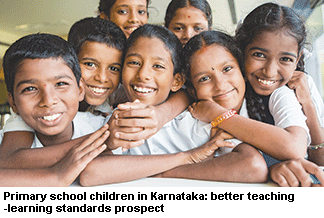Despite official discouragement and experiencing the thousand unnatural shocks and constraints that entrepreneurs are heir to, a growing number of determined edupreneurs have promoted businesses and launched innovative initiatives to improve learning outcomes in all sectors of Indian education
 WELL INTO THE SECOND DECADE OF THE 21st century, the world’s largest child and youth population which resides in the sovereign, secular, and adamantly socialist Republic of India governed by an insufferably holier-than-thou establishment whose argumentative blather is in inverse proportion to its achievements, is confronted with a bleak education landscape. Acquisition and assimilation of utilitarian, self-development knowledge and skillsets which would enable them to break out of the vicious cycle of ignorance, under-employment, low productivity and poverty, is likely to prove a difficult if not herculean, endeavour for the vast majority of the country’s 550 million children and youth.
WELL INTO THE SECOND DECADE OF THE 21st century, the world’s largest child and youth population which resides in the sovereign, secular, and adamantly socialist Republic of India governed by an insufferably holier-than-thou establishment whose argumentative blather is in inverse proportion to its achievements, is confronted with a bleak education landscape. Acquisition and assimilation of utilitarian, self-development knowledge and skillsets which would enable them to break out of the vicious cycle of ignorance, under-employment, low productivity and poverty, is likely to prove a difficult if not herculean, endeavour for the vast majority of the country’s 550 million children and youth.
This pessimistic forecast is prompted by the grassroots reality that every sector of the national education system has been reduced to mediocrity if not ruin, by the neglect and/or careless interventions of the Central, state and local governments over the past six decades.
For instance because of the isolationist autarkic mindsets of successive governments at the Centre, the importance of foundational early childhood care and education (ECCE), which over the past three decades has been discovered to be more important than university education in the light of recent neuroscience discoveries that the brains of children are almost fully developed by eight years of age (thanks in part to EducationWorld which during the past four years has convened four global ECCE conferences), dawned upon the Central government only last September prompting it to officially bless a National Early Childhood Care and Education (NECCE) policy draft. Whether the newly-elected Narendra Modi-led BJP/NDA government will take this initiative forward is a moot point.
Likewise, primary education in contemporary India is in the doldrums because very little learning happens in the country’s 1.2 million government schools defined by crumbling infrastructure, multigrade classrooms, massive teacher absenteeism, corporal punishment and abysmal learning outcomes. Repeated field surveys of Pratham, the globally-respected Mumbai-based NGO, encapsulated in its Annual Status of Education Report (ASER) indicate that over 50 percent of class V children in government rural primaries can’t read and comprehend class II texts and do simple subtraction and division sums. With free-of-charge government secondaries aggregating a mere 93,740 countrywide and providing at best marginally better quality education, it’s not surprising that of the 230 million children in school at the start of every academic year, barely 20 percent enter institutions of higher education.
Nor are post-independence India’s higher education institutions anything to write home about. Although some of them — notably the universities of Bombay, Calcutta and Madras — were established over 150 years ago and several much-hyped IITs over half a century ago, none of the country’s 37,000 colleges and 720 universities are ranked in the Top 200 of the annual global rankings of the world’s best universities league tables of the London-based Quacquarelli Symonds, Times Higher Education or the Shanghai Jiao Tong University, China. On the other hand, several Chinese, South Korean, and Singapore universities of recent vintage routinely figure in the Top 200 league tables.
“The sole objective of students has been reduced to obtaining high marks in State-mandated examinations or in entrance examinations to State-run professional institutions. This kind of ‘learning’ may help gain entry into higher education institutions, but it comes at the cost of employability,” writes Laveesh Bhandari, an alumnus of Boston University, former senior economist at the National Council for Applied Economics Research and currently the promoter-director of the Delhi-based Indicus Analytics Pvt. Ltd in an essay contributed to Getting India Back on Track (see p.110).
However, all is not lost for Indian education. Coincidently with the advent of the new millennium (and publication of EducationWorld, estb. 1999), a new awareness has dawned upon a rising number of educators and intellectuals that poor quality learning dispensed at all levels of the country’s moribund education system, is the greatest constraint on the growth and socio-economic development of this high-potential nation gifted with abundant natural and human resources and a glorious tradition of free enterprise and global trade.
Therefore, despite official and establishment discouragement, and experiencing the thousand unnatural shocks and constraints that entrepreneurs are heir to in this nation ranked #134 on the World Bank’s Ease of Doing Business index and #184 on the enforceability of contracts, in a spirit of enlightened self-interest a growing number of determined education entrepreneurs (aka edupreneurs) have promoted businesses and launched innovative initiatives to raise teaching-learning standards and outcomes in all sectors of Indian education.
Some of the more notable high-potential initiatives in early childhood care and education, primary-secondary, vocational and higher education are detailed in the following pages. However, please note the initiatives recounted are illustrative, not exhaustive. If there are other high-potential new initiatives in Indian education, we’d like to be educated about them.